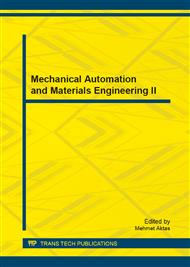[1]
Q.T. Yan. Flatness Control Performance Analysis of the Super-wide Tandem Cold Rolling Mill [Dissertation]. Beijing: University of Science and Technology Beijing, (2011).
Google Scholar
[2]
Przywara J, Spreitzhofer G, Dummler A. Innovative Contactless Flatness Measurement System for Cold Rolling Reversing Stands. Stahl und Eisen, Vol. 123 (2003), pp.57-60.
Google Scholar
[3]
Y. Peng, H. Li, R. Du. A Neural Network-based Shape Control System for Cold Rolling Operations. Journal of Materials Processing Technology, Vol. 202(2003) , pp.54-60.
DOI: 10.1016/j.jmatprotec.2007.08.075
Google Scholar
[4]
X. Zhang, S. Zhang, G. Tan, et al. A Novel Method for Flatness Pattern Recognition via Least Squares Support Vector Regression. Journal of Iron and Steel Research, International, Vol. 19(2012) , pp.25-30.
DOI: 10.1016/s1006-706x(12)60069-7
Google Scholar
[5]
H. He, Y. Li. A New Flatness Pattern Recognition Model Based on Cerebellar Model Articulation Controllers Network. Journal of Iron and Steel Research, International, Vol. 15 (2008), pp.32-36.
DOI: 10.1016/s1006-706x(08)60245-9
Google Scholar
[6]
Y. X. Shan, H. M. Liu, C. Y. Jia. A Recognition Method of New Flatness Pattern Containing the Cubic Flatness. Iron & Steel, Vol. 45 (2010), pp.56-60.
Google Scholar
[7]
D. J. Xu, C. Y. Jia, Y. C. Cui, Y. N. Ye. Study on BP Network Flatness Pattern Recognition Based on Quantum Particle Swarm Optimization Algorithm: Journal of Yanshan University Vol. 35 (2011), pp.35-39.
Google Scholar
[8]
X. D. Zhou, G. D. Wang. Orthogonal Polynomial Decomposition Model for the Flatness of Cold-rolled Strip. Iron & Steel, Vol. 32 (1997), pp.46-47.
Google Scholar
[9]
H. S. Di, X. F. Zhang. Orthogonal Polynomial Decomposition and Mathematical Model for Measured Signals of Thin Strip. Iron & Steel, Vol. 30 (1995), pp.33-36.
Google Scholar
[10]
Q. D. Zhang, X. M. Zhou, J. T. Liu. Evalution and Statics Methods of Cold-rolled Strip Flatness. 2001 CSM Annual Meeting, Beijing, P. 57-60.
Google Scholar
[11]
J. B. Dai, W. B. Wu, Q. D. Zhang, et al. Recognition and Evaluation System for Strip Flatness on 2030 mm Cold Tandem Mills. Journal of University of Science and Technology Beijing, Vol. 25(2003), pp.572-574.
Google Scholar
[12]
L. Hao, H. S. Di, D. Y. Gong, et al. Software Development of Strip Flatness Off-line Display and Pattern Recognition. Journal of Northeastern University (Nature Science) , Vol. 31(2010), pp.1414-1416, 1420.
Google Scholar


